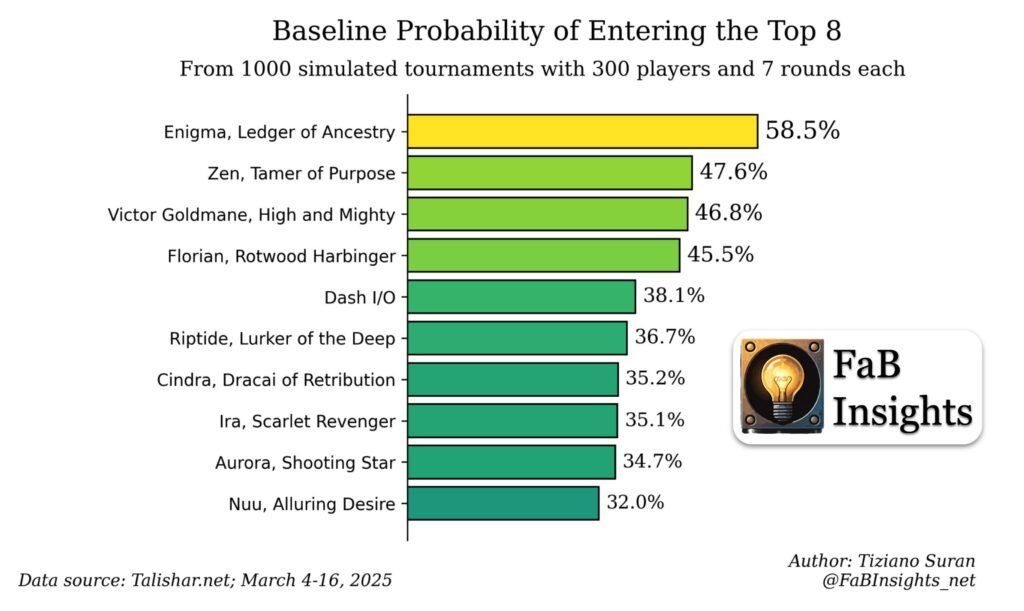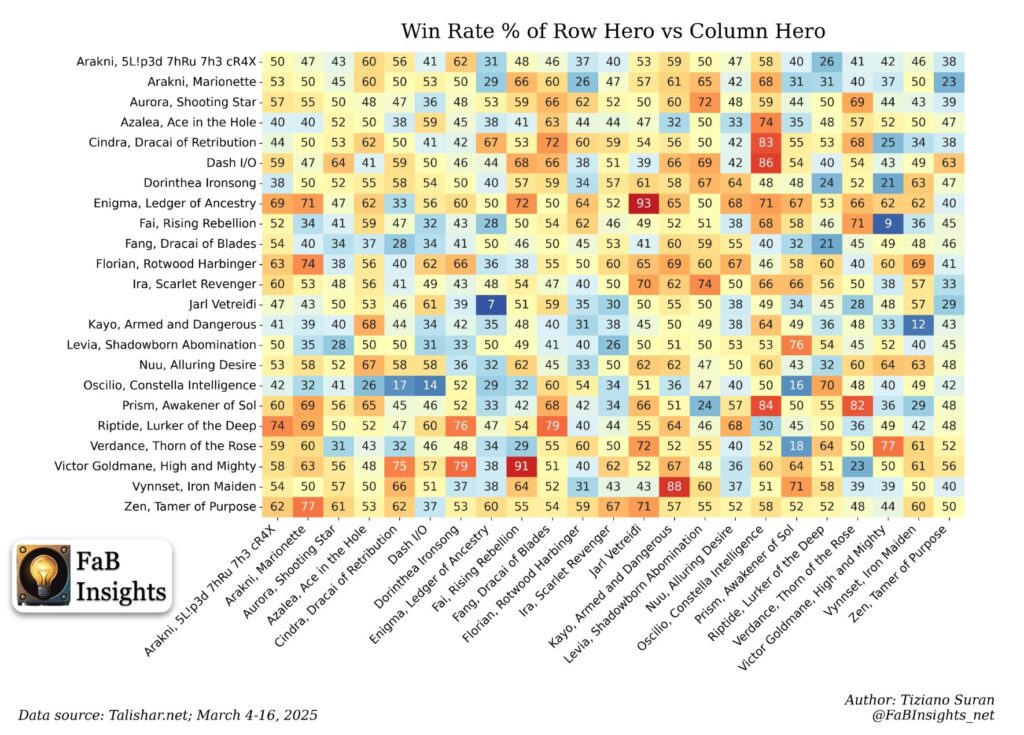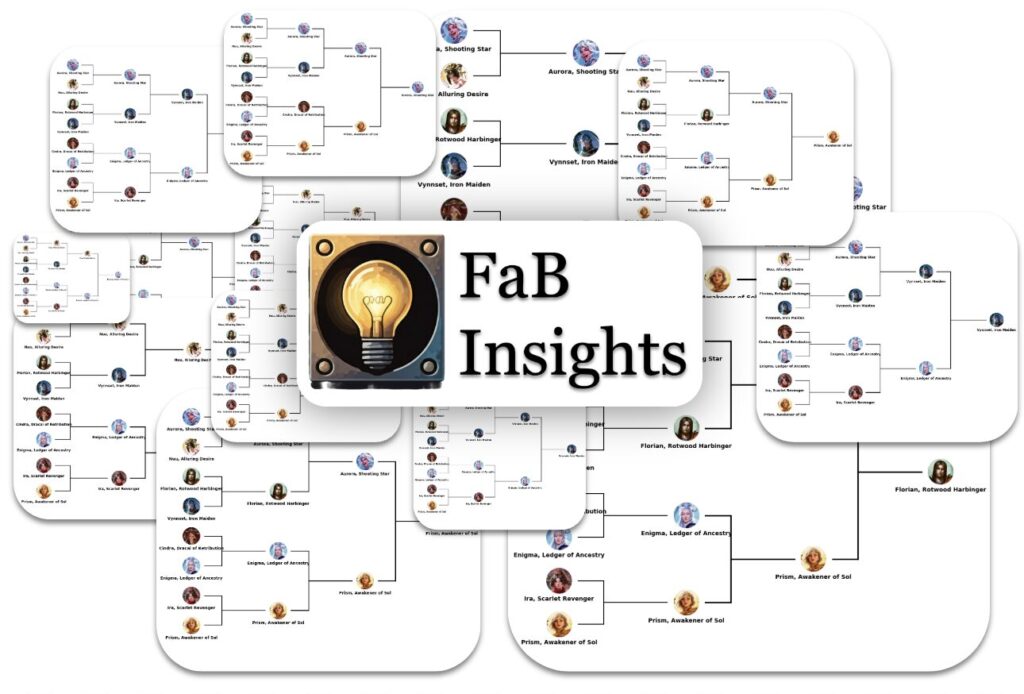What makes a Flesh and Blood hero successful in a tournament? In real events, pick rates play a huge role—more popular heroes naturally have more chances to reach the Top 8. But what if we leveled the playing field? What if every hero was chosen by the same amount of players?
Think of real tournaments as just one possible outcome in a vast multiverse of potential results (much like what you see in Marvel movies). What if a player shuffled their deck one more time? Or what if the opponent cut it at a different card? We cannot know how the outcome would have changed because we can witness to pnly one realization. In a game where luck plays a significant role, by simulating hundreds of events, we can however look at what is the most frequent outcome. This can help us choose the heroes with the highest baseline probability of winning – of course it is up to the player to know how to play the hero. In running these tournament simulations, one can also tweak the number of people picking each hero. So what if we got rid of any overhyped hero and just have everyone pick a hero at random? Such approach would help reveal which heroes have the strongest inherent potential, rather than just benefiting from popularity.
To explore this, I ran a Monte Carlo simulation—a powerful statistical method used in finance, physics, and even gambling—to simulate 1,000 tournaments with 500 players each. In each simulation:
- Players were randomly assigned a hero, ensuring every hero had the same representation.
- Match outcomes were determined probabilistically using hero-hero matchup win rates based on real game data (see plot at the end of article).
- Each tournament followed a 7-round Swiss format, just like a real event (minus Day 2).
- After Swiss rounds, I took the Top 8 heroes from each simulation and tracked how often each hero made it that far.
By repeating this process 1,000 times, I built a picture of which heroes consistently performed well when pick rates weren’t a factor. Thus, the plot below shows the % of times each hero made it in the top 8 out of 1000 simulated tournaments.

The Data Behind the Simulation
To ensure accuracy, I used matchup data from Talishar.net, filtering for games that lasted between 8 and 50 minutes and had at least three rounds. Additionally, I only included data from players who had played at least five games with a given hero since March 4th, resulting in a total dataset of 26,000 games. This should have significantly reduced the noise from less ‘serious’ games and from games with people having little experience with a certain hero. If you don’t see all heroes it is because i made sure to have enough matchup data to be statistically relevant, so I had to remove the less played ones (sorry Teklo players…).
Insights
The most recent Calling saw over 20% of players betting on Aurora. Although still among the strongest heroes, she currently does not present the highest probability of entering the top 8. These results suggest we might have seen way less players making it to the quarterfinals in Kobe had its popularity been lower. I would not exclude that many ex-Viserai Runeblade players found it easier to switch to her rather than moving to the different playstyle of Florian. To this regard, the simulations place him as one of the favourites, with over 40% probability of going to direct-elimination rounds (he also won the Calling btw). Other top heroes are the post-bonds-ban Zen and the aggro-unfriendly Victor, both with over 40% chance.
The one to place your bets on though is Enigma, surpassing all others by a big margin. She often loses against the constant flicking of Cindra but manages to frequently emerge victorious in many matchups (see matchup matrix below). Regarding Cindra, she is also one of the favourites – but I guess at the latest Calling people were particularly prepared to face her.
Dash I/O is also among the top ones. As can be seen from the matchup matrix, she poses a particular threat to both Cindra and Aurora, especially when they don’t block to prevent the grenades and other fun toys.
A last comment goes to Riptide. He does not see a lot of play at bigger tournaments, but is he ready for a comeback with the new set? I we’ll see how this observation will age.
The Big Takeaways
Results from real tournaments show just one possible outcome—a single thread in a vast tapestry of possibilities. This simulation allows us to glimpse alternate outcomes, exploring what might happen in different tournament scenarios. By running thousands of these hypothetical events, we gain a clearer picture of which heroes have the strongest inherent potential when given equal representation.
For competitive players, this means that metagame trends should always be taken as a proxy of power. The best hero for an event isn’t always the most popular one—it’s the one that consistently wins matchups, and possibly has favorable outcomes agains the most popular one. By looking beyond pick rates, we can refine our choices and increase our chances of making it to the top.
The Matchup Matrix
And last here is the matchup matrix, filtered to the best of my current capabilities from low-quality games.So how do you use it? For example, if you expect to face lots of Auroras at your next event, just go see who she tends to lose the most against, et voilà you pick the hero with the greates baseline success rate (and learn how to pilot it, hoping it does not tend lose badly agains all other heroes).
Enjoy and consider supporting my work on Patreon—your support helps me continue providing in-depth breakdowns and strategic insights for the Flesh and Blood community!




